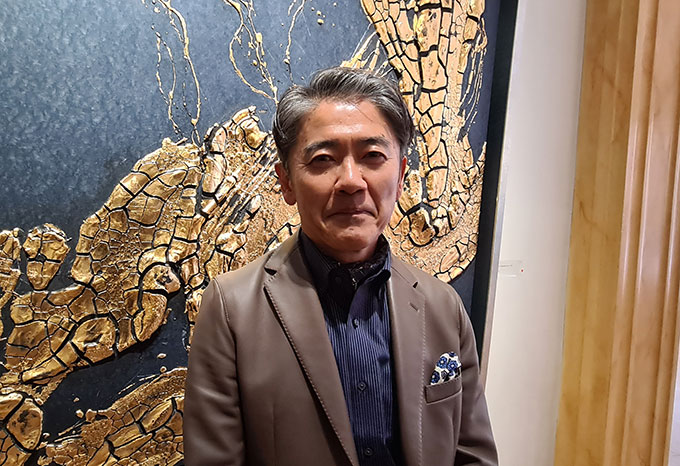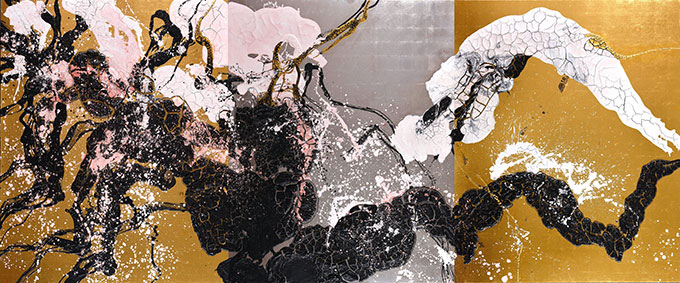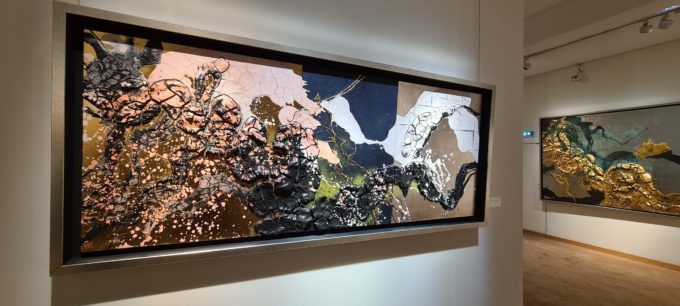Posted on March 29, 2022 in Arts & culture.
Takehiko Sugawara illuminates the Parisian gallery Taménaga
As an extension of its 50th anniversary, Galerie Taménaga in Paris is presenting the masterful works of Japanese artist Takehiko Sugawara until April 9.

Takehiko Sugawara – ©David Raynal
Already widely recognized in Japan, Takehiko Sugagawara is on the way to achieving the status of a major artist there. It is already considered by the curators of the most important museums as "the origin of the revival of Japanese painting". Abroad, international art historians are already saying of him that he is "one of Japan's most important living artists". The exhibition at the Taménaga gallery on avenue de Matignon in Paris (08) presents until April 9 more than 45 new works in which the artist has treated completely new subjects, such as the bewitching Aoike (blue ponds which reflect the foliage of nocturnal forests). "For this exhibition, the artist used techniques he had never used before, such as the extraordinarily refined midnight blue ganpishi paper, the production of which is unfortunately destined to cease shortly, due to the extreme difficulties of transmission. of knowledge with which its craftsmen are confronted” points out Mathieu Petitjean, the gallery's sales director.
Nihonga painting
Takehiko Sugawara was born in Tokyo in 1962. In 1989, he was admitted to the Tama University of Fine Arts and in 1994, he received the Young Talents Scholarship, awarded by the Gotoh Memorial Foundation. Several prestigious prizes were successively awarded to him: Yamatane Museum (1993), Mokichi Okada-MOA Art Museum (1998) and above all the Nikkei Nihonga Grand Prize (2004). Since 1991, museums have dedicated personal exhibitions to him: the Central Art Museum (Tokyo), The Shirane Togen Art Museum (Yamanashi); The Nerima Art Museum, (Tokyo). In addition, many Japanese museums exhibit his works in their permanent collections. The painter usually works on washi (paper made from mulberry fibre) stretched over a wooden panel. The artist's colors are made from a mixture of traditional Japanese nikawa glue and natural pigments. Highly recognized in Japan, and benefiting from a solid reputation internationally, his work is designated by some critics as heralding a new era for nihonga painting, “literally Japanese painting”. In some works on bare paper, he works in two stages. First, he applies a largely diluted mixture of glue and fine natural mineral pigments to the reverse. These cross the support by capillarity and eventually migrate towards the visible face. In a second step, the artist stretches the paper on a wooden panel then paints the visible side with a mixture of glue rich in thick pigments. The relative transparency of washi, the interplay of patterns on the surface and the additional relief provided by thick pigments create a unique visual depth.

Sugawara – Miharu – 227 x 545 cm – ©Takehiko Sugawara
Contemporary strength
In other works, he covers the washi beforehand with squares of gold, platinum or silver leaf. He then paints on the support and varies the mediums: mixture of nikawa glue and natural minerals mentioned above or mixture of nikawa, Indian ink and Japanese softwood ash. These materials, fired at a precise temperature for a precise time, retract on drying and thus form voluntary cracks that evoke the bark of Japanese cherry trees. The contemporary force that emanates from his works with which he adopts ancestral themes and techniques places the artist as one of the most remarkable contemporary Japanese painters. Takehiko Sugawara's works are an ode to nature. The latter is his first inspiration. “I'm not trying to reproduce traditional themes of Japanese painting. I am simply attracted by the life and strength of trees, especially cedars millennia. Trees that can be 7000 years old and that live well beyond our ages” explains the artist in Paris. Surveying the surrounding regions, the master sets out to discover extraordinary sites across the Japanese peninsula. He undertakes long walks alone in the middle of luxuriant forests or on the edges of rocky shores. Like a conqueror, he furrows nature and engulfs himself ever more deeply in his entrails in search of natural monuments.
sugi vitality
Recently, for example, the artist ventured to the island of Yakushima, south of Kyushu, in the Osumi archipelago. The island is famous for the richness of its fauna and its almost intact flora, thus giving to see a green landscape dotted with a thousand waterfalls with an almost enchanting atmosphere. Takehiko Sugawara has made his way to join the illustrious sugi (Japanese cedars) with millennial roots. Among them, the largest and oldest, the Jōmon Sugi is over 3000 years old. A few steps away, also stands the Daiō Sugi, certainly the most impressive. These deans of the forest inspired the latest works. From his usual journey through the great trees such as cherry blossoms or Japanese pines, Sugawara reveals to us that he was attracted by the majesty and vitality of the sugi. He observed them from a multitude of angles and points of view, at all hours of the day and night, before grasping the omnipotence and dynamics of the lines. This is what he shows us in this exceptional exhibition in Paris. Since 1998, the artist has been a professor at the University of Arts and Design in Kyoto and since 2012, his fame has spread to the rest of the world with important exhibitions in Asia and Europe. In 2015, the director of the very serious Ueno no Mori Museum (Tokyo and Kyoto) wrote: “Sugawara is at the origin of the revival of Japanese painting. ". In 2020, Timon Screech, of the School of Oriental and African Studies (University of London) wrote: “Sugawara stands out as one of Japan's most important living artists. »
Poetic and personal observation
Struck by the beauty and strength emanating from his natural environment, the artist freed himself from all the rules and constraints of traditional art to tend towards abstraction. “When we imagine Japanese art, we often think of Japanese prints that have no perspective. On the other hand, cherry trees make it possible to work on textures and volumes. This allows you to show all the dimensions of the subject » says Takehiko Sugawara. From this privileged relationship maintained with ancient trees, Sugawara restores a poetic and personal observation of the plant world. “A few years ago, when I first showed this work, my works were only done in Indian ink, a black and white world. I understood that my work was not strong enough to really reach the European public. This is the reason why I changed my style and material » emphasizes the artist. From this privileged relationship maintained with ancient trees, Sugawara restores a poetic and personal observation of the plant world. Takehiko Sugawara hadn't exhibited in Europe since 2018, so that gave him four years to paint. " With this exhibition, during which his work reached an exceptional quality, which is reminiscent of that of the great Japanese masters, his career is undoubtedly about to experience a decisive turning point. explains Mathieu Petitjean in conclusion.
Art market
Fifty years after the opening of the Galerie Taménaga in Paris, avenue Matignon is once again consecrated as the leading European market place for works of art. The arrival of Takehiko Sugawara before that of the American artist Tom Christopher in June, but also the permanent and assumed presentation of masterpieces by Western Masters (Pablo Picasso, Max Chagall, Henri Matisse, Juan Gris, Georges Rouault, Raoul Dufy, Bernard Buffet), make the Taménaga gallery one of the safe bets on the Paris art market.
David Raynal
Click on the images to take a virtual tour of the exhibition: https://vr.masterart.com/tours/4136/galerie-tamenaga/takehiko-sugawara
Tamenaga Gallery
18, avenue Matignon – 75008 Paris
+ 33 (0)1 42 66 61 94
mpetitjean@tamenaga.fr
Drawing Now Art Fair: Tatiana Wolska winner 2024
The invention of language by Gertrude Stein and Pablo Picasso
The history of French women's golf at Golf du Sorbier









